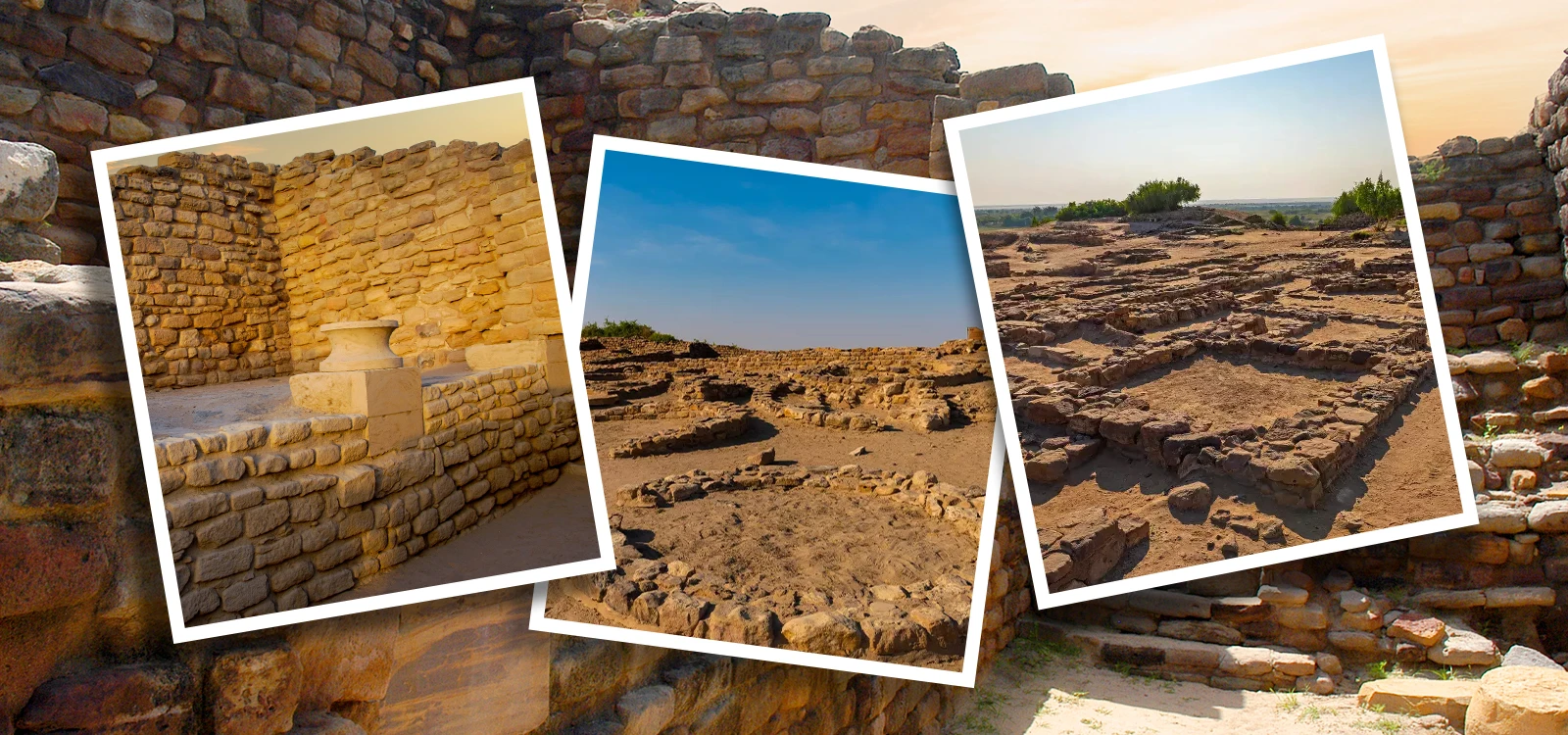Top Myths and Truths About the Harappan Civilization – Dholavira Edition
When you hear the words Harappan Civilization or Indus Valley Civilization, what comes to your mind? For many, it is a picture of mysterious ruins, undeciphered scripts, and an ancient culture that disappeared thousands of years ago. But did you know that many of the “facts” people believe about the Harappans are actually myths?
Among the most fascinating archaeological sites in India, Dholavira Harappan site stands out as one of the best places to separate truth from fiction. Located in the Rann of Kutch, Gujarat, Dholavira gives us clear information of Harappan Civilization—from their advanced city planning to their peaceful way of life. In fact, UNESCO declared Dholavira a World Heritage Site in 2021, adding even more pride to India’s heritage.
As you read this blog, you will uncover some of the most common myths about Harappan Civilization and the truths that archaeology reveals. If you are fascinated by ancient cultures or planning a trip to unique archaeological sites in India, this guide is your chance to dive deeper into one of the world’s earliest urban societies. And when you do, remember that a stay at Evoke Dholavira offers you comfort, luxury, and the closest access to this magnificent Harappan city.
Common Myths About the Harappan Civilization
Myth 1: The Harappan Civilization Believed in "Rebirth" as a Core Religious Principle
One widespread belief is that the Harappans strongly followed the idea of “rebirth,” similar to later Hindu traditions. But the truth is, there is no solid evidence from the Dholavira Harappan site or other ruins of the Indus Valley Civilization to support this. Burial practices found here include both cremation and inhumation (burial), but that does not directly point to a doctrine of rebirth.
This myth probably comes from trying to connect Harappan beliefs to modern Indian religions. But the reality is, while they may have believed in life after death, their religious practices were unique and not fully understood.
Myth 2: The Harappan Society Was Completely Egalitarian
Some people believe Harappan society was completely equal, with no rich or poor classes. At first glance, the neat planning of cities and the absence of grand palaces or royal tombs might suggest equality.
However, facts about Harappan Civilization show otherwise. Archaeologists have found differences in house sizes at Dholavira Harappan site—some large and elaborate, others simple. This indicates that society likely had some form of social hierarchy. People may not have had kings like in Egypt, but leaders or administrators surely existed.
Myth 3: The Harappans Lacked Religion Because of No Monumental Temples or Palaces
Since no giant temples or statues like those of Mesopotamia or Egypt were found, many assume the Harappans had no religion. This is a myth.
Archaeological evidence from Dholavira and other sites shows that they practiced rituals and worshipped symbols like the “Mother Goddess” figurines, animals, and sacred trees. They also had fire altars. While they may not have built massive temples, their spirituality was very much alive.
Myth 4: The Harappan Civilization Had Large Armies and Frequent Warfare
Many think that the Harappans, like other ancient civilizations, were always at war with each other. However, no strong evidence supports this.
Unlike other archaeological sites in India, weapons discovered at Dholavira are minimal and seem more for hunting than war. Fortified walls in the city were more likely for protection against floods or natural threats rather than battles. This suggests the Harappans lived in a generally peaceful society.

Established Truths About the Harappan Civilization
Truth 1: Advanced Urban Planning
If there’s one thing the Harappans were masters at, it was city planning. At the Dholavira Harappan site, you can still see wide streets, well-laid residential areas, and fortified sections. Their water conservation system—giant reservoirs and channels—was far ahead of its time.
These facts about Harappan Civilization prove they were not just simple farmers but skilled urban planners who cared about hygiene, comfort, and sustainability.
Truth 2: Extensive Trade Networks
The Indus Valley Civilization was deeply connected with the world around it. Archaeologists found Harappan seals in Mesopotamia, suggesting trade links across seas. Items like beads, ornaments, and pottery found at Dholavira show their craftsmanship and trading abilities.
Trade was not just local; it was international. This makes the Harappans one of the first global traders of history.
Truth 3: Unique Writing System
One of the most mysterious facts about Harappan Civilization is their script. Found on seals and tablets, the Harappan writing system remains undeciphered to this day.
At Dholavira Harappan site, a large signboard with Harappan script was discovered, possibly the world’s first “advertisement” or public display board. This proves they had an advanced way of communication, though we are yet to crack its meaning.
Truth 4: Religious Beliefs and Practices
As mentioned earlier, while they did not build grand temples, the Harappans had a spiritual side. Evidence suggests they worshipped deities linked to fertility, animals, and nature. Fire altars at Dholavira point to organized rituals.
This challenges the myth that they were a religion-less society. Instead, their beliefs were unique, shaped by their environment and culture.
Truth 5: Generally Peaceful Culture
Unlike other ancient civilizations, the Harappans were not obsessed with war. Few weapons and no signs of massive battles have been found at archaeological sites in India like Dholavira.
Instead, they focused on trade, farming, and community life. Their peaceful nature is one reason why they could thrive for centuries without collapse from constant wars.
Truth 6: Evidence of Social Organization and Governance
Even though no kings’ palaces or thrones have been found, the highly organized planning of cities proves there was some central authority. Someone had to decide how streets would be built, how water would be stored, and how trade would be managed.
The information of Harappan Civilization from Dholavira shows clear evidence of governance—perhaps a council or group of leaders rather than a single ruler.
Why Visit Dholavira Today?
Learning the facts about Harappan Civilization is fascinating, but nothing beats seeing it with your own eyes. At the Dholavira Harappan site, you can walk through ancient streets, see the incredible water reservoirs, and imagine life 4,500 years ago.
And after exploring, you deserve comfort and relaxation. That’s where Evoke Dholavira comes in. Nestled close to the site, this property offers modern cottages, authentic cuisine, and warm hospitality. With guided tours, complimentary transfers from Bhuj, and luxury amenities, your trip to this UNESCO World Heritage Site becomes truly unforgettable.

Conclusion
The Indus Valley Civilization was not just another ancient culture—it was a pioneer of urban living, trade, and peaceful coexistence. While myths paint a confusing picture, the truths about the Harappan Civilization show us a society that was advanced, thoughtful, and creative.
So, the next time you hear stories about the Harappans, remember the lessons from Dholavira Harappan site. Better yet, plan a visit, explore the ruins yourself, and stay at Evoke Dholavira, where history meets comfort in the heart of Kutch.
FAQs – Your Questions Answered
The Harappans had advanced urban planning, water systems, trade networks, and unique scripts. The Dholavira Harappan site is the best place to see these achievements.
Dholavira is one of the largest Harappan cities and a UNESCO World Heritage Site, showcasing the brilliance of the Indus Valley Civilization.
Visitors can see city layouts, reservoirs, fortifications, and artifacts that provide clear information of Harappan Civilization.
The Harappan Civilization dates back around 4,500 years, flourishing between 2900 BCE to 1500 BCE.
The Indus Valley Civilization was known for peaceful living, advanced planning, and trade without relying on constant wars.
Yes, tourists can reach Dholavira from Bhuj with pickup and drop services, especially when staying at Evoke Dholavira.
Other famous archaeological sites in India include Lothal, Mohenjo-daro, Harappa, Nalanda, and Hampi.
Evoke Dholavira offers comfort, local cuisine, guided tours, and proximity to the site – perfect for travelers exploring this World Heritage treasure.

